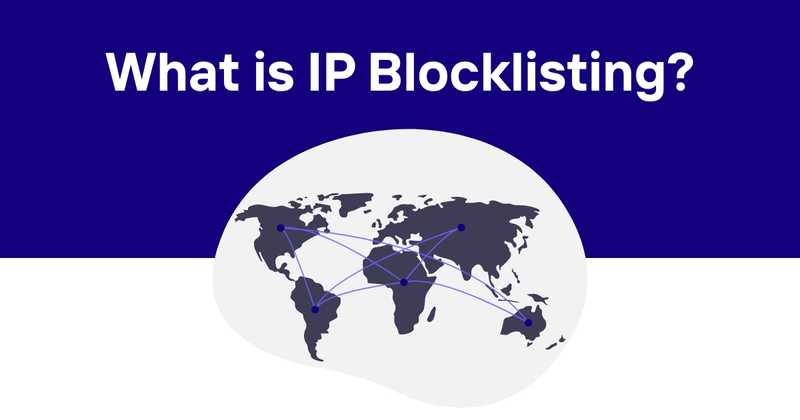What is IP Blocklisting?
IP blocklisting is a critical security measure used to protect networks and systems from potentially malicious traffic. As a software developer, understanding IP blocklisting is essential for building robust, secure applications and maintaining the integrity of your digital infrastructure.
This comprehensive guide will explore the ins and outs of IP blocklisting, including how it works, its benefits and challenges, and best practices for implementation. We'll also examine related concepts like IP reputation and provide actionable advice for developers looking to leverage blocklisting effectively.
Table of Contents
- Understanding IP Blocklisting
- How IP Blocklisting Works
- Types of IP Blocklists
- Benefits of IP Blocklisting
- Challenges and Limitations
- IP Reputation and Its Importance
- Implementing IP Blocklisting: Best Practices
- Monitoring and Maintaining Blocklists
- IP Blocklisting vs. Other Security Measures
- Legal and Ethical Considerations
- Future Trends in IP Blocklisting
- Conclusion
Understanding IP Blocklisting
IP blocklisting, also known as IP blacklisting, is a security technique used to prevent access from specific IP addresses or ranges that are suspected of malicious activity. It acts as a filter, blocking traffic from these identified sources before it can reach your network or application.
For software developers, IP blocklisting is a crucial tool in the security arsenal. It helps protect against various threats, including:
- Spam and email abuse
- Brute force attacks
- Distributed Denial of Service (DDoS) attacks
- Data scraping
- Unauthorized access attempts
By implementing IP blocklisting, developers can significantly reduce the attack surface of their applications and infrastructure, enhancing overall security posture.
How IP Blocklisting Works
The process of IP blocklisting involves several key steps:
-
Identification: Suspicious IP addresses are identified through various means, such as:
- Analysis of traffic patterns
- Reports from security researchers or organizations
- User complaints
- Automated threat intelligence feeds
-
Listing: Once identified, these IP addresses are added to a blocklist database.
-
Implementation: The blocklist is integrated into security systems, firewalls, or applications.
-
Filtering: Incoming traffic is checked against the blocklist. If a match is found, the traffic is blocked or redirected.
-
Logging and Analysis: Blocked attempts are typically logged for further analysis and reporting.
For example, when an HTTP request reaches your web server, the IP address of the requester is checked against your blocklist. If it's present, the request is denied before it can interact with your application logic.
Types of IP Blocklists
There are several types of IP blocklists, each serving different purposes:
-
Public Blocklists: Maintained by security organizations and freely available. Examples include Spamhaus and AbuseIPDB.
-
Private Blocklists: Created and maintained by individual organizations for their own use.
-
Real-time Blocklists (RBLs): Dynamic lists updated in real-time, often used for email spam prevention.
-
Geographic Blocklists: Block traffic from specific countries or regions.
-
Reputation-based Blocklists: Utilize IP reputation scores to determine blocking.
As a developer, you might use a combination of these depending on your specific security requirements and the nature of your application.
Benefits of IP Blocklisting
Implementing IP blocklisting offers several advantages:
-
Reduced Attack Surface: By blocking known malicious IPs, you significantly decrease the potential entry points for attacks.
-
Resource Conservation: Blocking unwanted traffic early saves server resources and bandwidth.
-
Improved Performance: With less malicious traffic to process, legitimate users experience better performance.
-
Compliance: Many regulatory frameworks require implementation of security measures like IP blocklisting.
-
Cost-Effective: Compared to more complex security solutions, IP blocklisting is relatively simple and cost-effective to implement.
-
Customizable Protection: You can tailor blocklists to your specific needs and threat landscape.
Challenges and Limitations
While IP blocklisting is a powerful tool, it's not without challenges:
-
False Positives: Legitimate users might be blocked if they share an IP with a malicious actor or if the IP was previously used for malicious activities.
-
Dynamic IP Addresses: Many ISPs use dynamic IP allocation, meaning a blocked IP might later be assigned to a legitimate user.
-
IP Spoofing: Sophisticated attackers can forge IP addresses to bypass blocklists.
-
Maintenance Overhead: Keeping blocklists up-to-date requires ongoing effort and resources.
-
Scalability Issues: As blocklists grow, checking against them can introduce latency.
-
Incomplete Protection: IP blocklisting alone is not sufficient for comprehensive security.
To mitigate these challenges, it's crucial to combine IP blocklisting with other security measures and implement intelligent, adaptive blocking strategies.
IP Reputation and Its Importance
IP reputation is a key concept closely related to IP blocklisting. It refers to the trustworthiness of an IP address based on its historical behavior. IP reputation systems assign scores to IP addresses, considering factors such as:
- Past involvement in spam or malicious activities
- Volume and pattern of traffic
- Age of the IP address
- Geolocation
- Presence on known blocklists
For developers, understanding and leveraging IP reputation can enhance the effectiveness of your blocklisting strategy. Instead of a binary block/allow decision, you can implement more nuanced policies based on reputation scores.
For example, you might:
- Allow traffic from high-reputation IPs without additional scrutiny
- Apply extra security checks to traffic from medium-reputation IPs
- Block traffic from low-reputation IPs outright
Implementing an IP reputation system can help reduce false positives while maintaining strong security. Several third-party services provide IP reputation data that you can integrate into your applications.
Implementing IP Blocklisting: Best Practices
When implementing IP blocklisting in your applications or infrastructure, consider these best practices:
-
Use Multiple Sources: Rely on a combination of reputable public blocklists, private lists, and real-time threat intelligence feeds.
-
Implement Whitelisting: Maintain a whitelist of known good IPs to prevent accidental blocking of critical traffic.
-
Consider Temporary Blocks: For less severe offenses, implement temporary blocks that expire after a set period.
-
Log Extensively: Keep detailed logs of blocked attempts for analysis and troubleshooting.
-
Implement Rate Limiting: Use rate limiting in conjunction with blocklisting to mitigate brute force attacks.
-
Use Reverse Proxy: Implement blocklisting at the reverse proxy level to offload processing from your application servers.
-
Automate Updates: Set up automated processes to update your blocklists regularly.
-
Monitor for False Positives: Regularly review logs and user reports to identify and rectify false positives.
-
Implement Gradual Blocking: Use a tiered approach where suspicious IPs face increasing restrictions before outright blocking.
-
Educate Users: Provide clear information to users about your blocklisting policies and how to request unblocking if needed.
Here's a simple example of how you might implement basic IP blocklisting in a Node.js Express application:
const fs = require('fs');
const app = express(); // Load the blocklist
let blocklist = new Set(fs.readFileSync('blocklist.txt', 'utf-8').split('\n'));
// Middleware to check IP against blocklist
app.use((req, res, next) => {
const ip = req.ip;
if (blocklist.has(ip)) {
return res.status(403).send('Access Denied');
}
next();
});
// Your routes and other middleware here
app.listen(3000, () => console.log('Server running on port 3000'));
This example demonstrates a basic implementation. In a production environment, you'd want to add more sophisticated logic, error handling, and potentially use a database instead of a file for the blocklist.
Monitoring and Maintaining Blocklists
Effective IP blocklisting requires ongoing monitoring and maintenance. Key aspects include:
-
Regular Updates: Keep your blocklists current by updating them frequently, ideally in real-time.
-
Performance Monitoring: Watch for any impact on system performance as your blocklists grow.
-
Analyzing Blocked Traffic: Regularly review logs of blocked attempts to identify patterns and emerging threats.
-
Tuning and Optimization: Adjust your blocking rules based on observed patterns and false positive rates.
-
User Feedback Mechanism: Implement a system for users to report false positives and request unblocking.
-
Auditing: Periodically audit your blocklists to remove outdated entries and ensure accuracy.
Consider implementing automated tools to assist with these tasks. Many security information and event management (SIEM) systems offer features to help manage and optimize IP blocklists.
IP Blocklisting vs. Other Security Measures
While IP blocklisting is a valuable security tool, it's most effective when used as part of a comprehensive security strategy. Here's how it compares to and complements other security measures:
| Security Measure | Strengths | Limitations | Synergy with IP Blocklisting |
|---|---|---|---|
| Firewalls | Deep packet inspection, stateful traffic analysis | Resource-intensive for large-scale blocking | IP blocklisting can offload basic filtering |
| Intrusion Detection Systems (IDS) | Real-time threat detection, behavior analysis | Can be bypassed by sophisticated attacks | IDS can feed into dynamic IP blocklists |
| Web Application Firewalls (WAF) | Application-layer protection, custom rule sets | Complex to configure, potential performance impact | IP blocklisting can reduce load on WAF |
| Authentication Systems | User-level access control | Don't protect against network-level attacks | IP blocklisting can prevent credential stuffing attempts |
| Encryption | Protects data confidentiality | Doesn't prevent unauthorized access attempts | IP blocklisting can reduce attack surface for encrypted services |
Legal and Ethical Considerations
When implementing IP blocklisting, it's crucial to be aware of potential legal and ethical implications:
-
Privacy Laws: Ensure your blocklisting practices comply with relevant data protection regulations like GDPR or CCPA.
-
Transparency: Be clear about your blocklisting policies in your terms of service or privacy policy.
-
Due Process: Implement a fair process for users to contest their blocking and request removal from blocklists.
-
Discrimination Concerns: Be cautious about geographic-based blocking, as it could potentially be seen as discriminatory.
-
Liability: Consider the potential liability if your blocklist incorrectly identifies an IP as malicious.
-
Data Sharing: If you're sharing blocklist data with third parties, ensure you have the right to do so.
Always consult with legal experts to ensure your IP blocklisting practices are compliant with applicable laws and regulations.
Future Trends in IP Blocklisting
As the threat landscape evolves, so too will IP blocklisting techniques. Some emerging trends to watch include:
-
AI and Machine Learning: Using advanced algorithms to predict and identify malicious IPs more accurately.
-
Blockchain-based Reputation Systems: Decentralized, tamper-resistant IP reputation tracking.
-
IPv6 Considerations: As IPv6 adoption grows, blocklisting strategies will need to adapt to the vastly larger address space.
-
Integration with Threat Intelligence Platforms: More comprehensive, real-time threat data incorporation.
-
Behavioral Analysis: Moving beyond simple IP-based blocking to more sophisticated behavior-based blocking.
-
Cloud-native Solutions: Blocklisting services optimized for cloud and microservices architectures.
Staying informed about these trends will help you evolve your security strategies to meet future challenges.
Conclusion
IP blocklisting is a fundamental security technique that every software developer should understand and implement. While it has its challenges and limitations, when properly implemented and maintained, it serves as a crucial first line of defense against a wide range of cyber threats.
By combining IP blocklisting with other security measures, staying informed about emerging trends, and following best practices, you can significantly enhance the security of your applications and infrastructure. Remember, security is an ongoing process, not a one-time implementation. Regularly review and update your IP blocklisting strategies to stay ahead of evolving threats and maintain robust protection for your digital assets.



